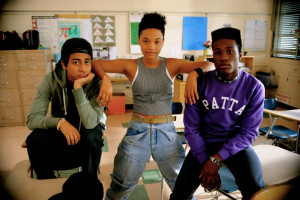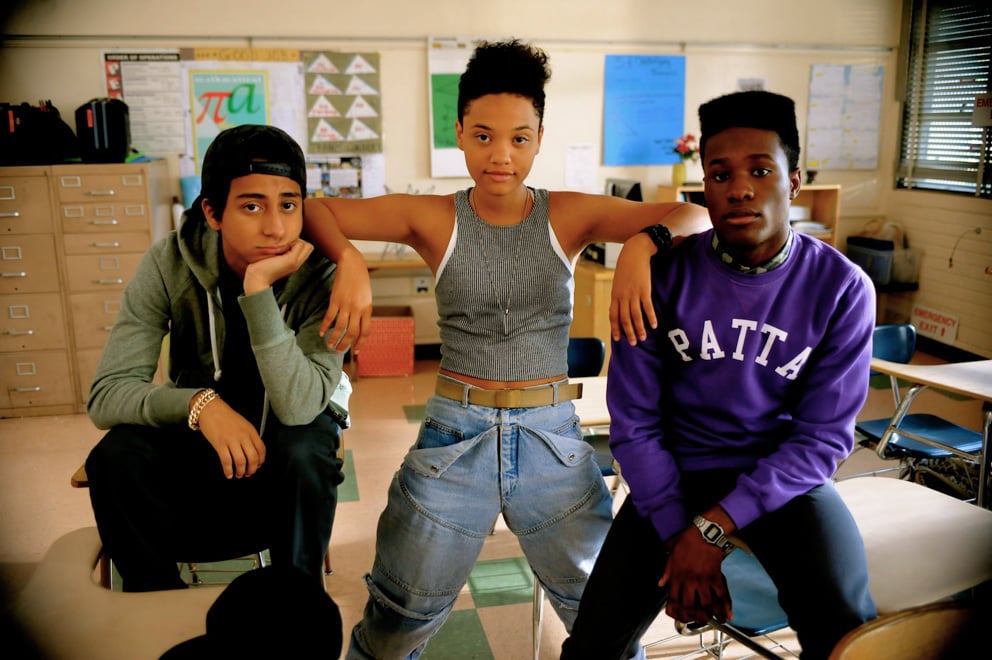
One of the first films I saw at this year’s Sundance Film Festival was Jennifer Siebel Newsom’s documentary “The Mask You Live In,” about how we need to redefine modern masculinity to allow men to express a complex range of emotions and vulnerability. It was a film with an important message, if a bit formulaic in style; what I hadn’t expected was how much it would end up framing my entire Sundance Film Festival experience. Would I have been cheering as hard for all the films, like “Songs My Brothers Taught Me” and “Christmas, Again,” that featured sensitive men that cry? Probably. But perhaps I’d also have been more forgiving of yet another display of gratuitously naked ladies or jokes about high school boys watching porn.
I wanted to rejoice in “Cronies” and “Dope,” two stylistically innovative films by emerging black auteurs, a rarity at Sundance, which tends to be the breeding ground for straight, white, male mumblecore auteurs — if we’re going to assign a stereotype. So it was disappointing to discover that two of the films that should have been among the most “atypically Sundance” films both wore their quirkiness on their sleeves more so than almost every other film I saw at the festival — and they mostly featured women solely for their tits and asses, with little to no character development. I kept thinking about the age-old stereotypes about women and men’s relationships with women that both films were perpetuating, even as they were trying to break racial stereotypes. Not every film can be as across-the-board nuanced as Justin Simien’s “Dear White People,” which, in retrospect, I think was undervalued for its fabulous female and gay characters.
Both “Cronies” and “Dope” have a great sense of place and a great understanding of the way that violence and drugs tend to find their way into poorer black neighborhoods in America, and consequently, into the lives of those living there — even if you’re the biggest book nerd on the block. And interestingly enough, each film opens with a dictionary definition of its title, itself a piece of slang. In “Cronies,” two twenty-something life-long St. Louis friends, Louis (George Sample III) and Jack (Zurich Buckner), grapple with the fact that Jack shot and killed Louis’ abusive father back when they were kids to defend Louis. Both seem like harmless men today who wouldn’t willingly get involved in violence or crime, but it finds them. In “Dope,” a trio of Inglewood, California teens — self-proclaimed nerds, interested in what the film refers to as “white shit,” like getting good grades and going to college — wind up pinned with several kilos of MDMA and a gun that they have to deal with; they’d prefer to be focusing on their college admission interviews. Their circumstances get in the way of leading their lives peacefully.
Shot in black and white, writer-director Michael Larnell’s “Cronies” opens with glimpses down the streets of the neighborhood where it takes place, taking something plain and pedestrian and rendering it romantic through cinematographer Federico Cesca’s impeccable eye. The soundtrack is filled with local music, heavily curated from unknown bands, which makes the film feel richly embedded in St. Louis culture. It’s structurally interesting, too: The film involves a series of interviews with each of its main characters, talking honestly into lens about each other, their concerns, their hopes and dreams, and their lives. The action in the film takes place over the course of an evening, where the two best friends and their new white friend Andrew (Brian Kowalski) smoke dope, hang out, chat and ogle women; the interviews seem to have happened at a separate time and get interspersed throughout as a nice counterpoint.
Louis is also a relatively new father, living with his girlfriend, the mother of his child, and he’s grappling with taking on that responsibility. His girlfriend is portrayed with some tenderness, as is their relationship, but is never a key part of the film, which is ultimately a bromance. The film is meant to be about Louis and Jack repairing the damage done between them, celebrating their friendship, and ultimately getting Louis to the point where he’s able and willing to grow up. It’s not that it doesn’t do all of this, but it’s contrived and never emotionally involving: The end point is always clear, and there’s little depth to their friendships. It doesn’t help that much of their bonding involves staring lasciviously at half-naked ladies at parties.
Nevertheless, “Cronies” does announce two new major talents, both current graduate students at New York University under the tutelage of Spike Lee: director Larnell and cinematographer Cesca. The film is rich in atmosphere, and it’s clear that Larnell has stories to tell, that he wants to put his hometown and all the unique parts of its culture on screen. He’s also got a lot of insight into the plight of a young black man in this lower-middle class neighborhood — the roles that get assigned almost by default, and the way that pushing against these can be difficult. It’s part of what makes Louis’s ventures into parenthood not yet wholly successful. Similarly, Cesca’s cinematography is stunning, with great contrast and thoughtful framing. It’s only his first film, and he’s certainly a talent to watch.

Rick Famuyiwa’s “Dope” is the flashier and more fun of the pair: it moves at a breakneck pace, which is saying a lot for a film that is essentially a shaggy-dog tale. That it won a Sundance award for editing, its biggest weakness, is perhaps proof of how little the festival’s juried awards have to do with merit. “Dope” clearly takes after John Hughes movies of the ‘80s, sharing both the energy of those films and their stereotypical two-dimensional characters. The stereotypes have shifted a bit, though: a young black man can be the overachieving geek and surround himself with friends of color, including a butch lesbian (Kiersey Clemons) and another geek in a sun hat (Tony Revolori). They’re unconventional black stereotypes, but stereotypes nonetheless. His friends, especially, never rise above the level of sidekick: they’re underdeveloped.
All Malcolm (the charismatic and mesmerizing Shameik Moore) wants is to ace his college interviews, avoid the school bullies, and get a pretty girl (Zoë Kravitz, stunning) to talk to him. But because of where he lives, he ends up at a party in the wrong place at the wrong time and suddenly has to dispose of kilos of dope — turning it into the police isn’t an option, because he’s black and from where he’s from. Of course, when he passes through the metal detector at school with a gun in his backpack, and it beeps, the security officer assumes the detector must be broken, so strong is his reputation as a geek. When Malcolm realizes he has to sell the drugs, he even easily sets up his drug shop in the school science laboratory under the guise of a science project. And there’s certainly some fun to be had with these subversive stereotypes. Yet they are vague geeks: Malcolm wants desperately to go to Harvard and is supposed to be very smart and ambitious, yet he has no discernible academic interests or passions.
Malcolm is still motivated by and ultimately rewarded with winning the girl, who has very little personality outside of her beautiful face. The other women he meets are just as bad or worse, cliches or gratuitously scantily-clad. The film expects to get some of its biggest laughs from Malcolm’s decision to stick around and wait for a man he’s supposed to meet, after being greeted by that man’s daughter, who’s wearing nothing but a bathrobe — which she quickly disposes of before jumping Malcolm.
Malcolm, a virgin, is sweetly shy and tentative around women, but we’re also meant to laugh and applaud when he goes home to masturbate to some unsavory porn. It’s not as if this isn’t happening all over the place — it is, and it’s a big issue that “The Mask You Live In” addresses, in how it creates boys who don’t know how to relate to or empathize with women. We’re meant to laugh along with this scene of boys being boys, but for a film that hopes to be progressive, it’s incredibly regressive when it comes to sexism and masculinity. It sucked a lot of the joy out of the film for me. A lot of the humor in “Dope” didn’t work for me, but I was definitely the exception in the audience at Eccles Theatre, not the rule.
It’s a shame, because there’s much to like about “Dope.” It’s got visual panache and a great hip-hop soundtrack. It finds a way to be a modern-day John Hughes movie without literally announcing itself as a Hughes successor the way “Easy A” did. It also features a cast of new talents with great comedic timing and faces you don’t want to stop looking at — especially Kravitz, Clemons, Revolori and Moore. I hope they get a better vehicle next time that really lets them shine.
“Dope” works so hard to hammer home its message about how young black men are boxed into certain categories that it just ends up giving its characters new, equally confining, boxes to inhabit. It never leaves room for subtlety to transcend its message. It tries to do, to some degree, what “Dear White People” does better: address racism head-on. Where Simien’s film succeeds and “Dope” fails is in getting so specific about black issues that it ends up telling a more universal story about identity, the construction and performance of identity, and the insecurities that feed the problems we have with it. “Dope” simply reminds us of the stereotypes that exist for characters of color and offers up a few new ones that might more typically have been assigned to white characters. It doesn’t actually treat these characters are more complicated, three-dimensional human beings, largely because of genre requirements, and it’s a serious missed opportunity.
Contact Alexandra Heeney at aheeney ‘at’ stanford.edu.
